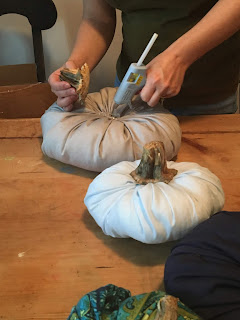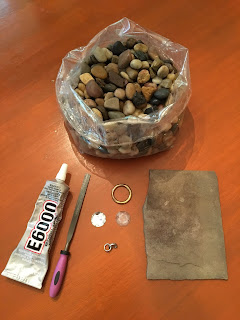With September, comes full-fledged pumpkin season! It's pumpkin everything! - pumpkin spice coffees, pumpkin lattes, pumpkin bread, pumpkin bars, pumpkin decor. If it's pumpkin, it's currently here! Pumpkin, Pumpkin, Pumpkin, Pumpkin...
So in the pumpkin spirit, we here at Out 2 Lunch got busy making some pumpkin decorations for our homes. A couple years ago, I found this pinterest tutorial for velvet pumpkins that I loved. I made a whole series of pumpkins in velvets and satins that now decorate my home, my mother's and mother-in-law's homes, as well as the homes of some of my friends. I was on a pumpkin roll!
With our love here for vintage fabrics and creative re-purposing, Stacy and I decided to make some fabric fall pumpkins using re-purposed clothes. We both picked some items (shirts, skirts, etc.) that fit the color scheme looks we each wanted. You can definitely see some of our personality differences here! Stacy chose some gorgeous blues/browns for a very beachy blue fall look. And I definitely went for a more silver/black gothic glam look.
We had SO much fun making these and we're sharing our process as well as our hard-learned do's and do not's!
Have fun, re-purpose and we'd love to see your pics! In fact, tag us on instagram (out2lunchdesigns) with your fabric pumpkin pics and we'll re-post them!
Materials:
 Clothing/Fabric to cut up
Clothing/Fabric to cut up Doll Making or Decorator's Needles
- very long sewing needles
Dried Pumpkin Stems or Stick Pieces
Heavy Duty Thread
Cotton Stuffing
Sharp Scissors
Hot Glue Gun & Glue

Step One: Cutting
Cut your fabric into large circles (doesn't need to be exact). Keep in mind that the pumpkin will be almost half the size of the circle when finished (ie- 12" circle will make roughly a 6-7" pumpkin). For very large pumpkins, cut 20" or larger diameter circles.
Step Two: Sewing
Run a long, doubled piece of Heavy Duty Thread through your long needle. Make sure to use strong thread (we had some break as were tying off our pumpkins, and had to start them all over)! To sew the pumpkins start on one edge and run the needle around the edge using a loose up and down running stitch.. It doesn't have to be perfectly even, and a loose stitch 1/2" wide is fine. Make sure though that you have enough thread to go all the way around with some hanging out each end. The fabric will gather as you sew and push it along the thread. Once stitched all the way around, gently pull the strings on both ends to gather the pumpkin in, leaving about a fist-sized hole at the top.
Step Three: Stuffing
Carefully stuff wads of cotton into the pumpkin to fill to desired plumpness. More stuffing yields a rounder, more ball like pumpkin; slightly less stuffing makes a squattier, wider pumpkin. Once stuffed, pull strings together to close stuffing hole and tie into a knot. Be gentle with this - this is where we broke some threads!

Step Four: Finishing
 You now have a nice round stuffed ball. Re-thread your long needle and knot the end. Run your needle/thread back and forth across the edges of the closed off hole a couple times, just to pull them tighter together, tie off thread. Next, run your needle/thread straight down through the gathered edges, through the pumpkin, and out the bottom of the pumpkin. Turn your needle around and run it back up. Repeat this step a couple times, gently pulling the top and bottom of the pumpkin towards each other. Knot and cut off thread when done. This will indent the top and bottom to form a more realistic pumpkin shape. You will really need the long doll needles for this step, especially with the larger sized pumpkins!
You now have a nice round stuffed ball. Re-thread your long needle and knot the end. Run your needle/thread back and forth across the edges of the closed off hole a couple times, just to pull them tighter together, tie off thread. Next, run your needle/thread straight down through the gathered edges, through the pumpkin, and out the bottom of the pumpkin. Turn your needle around and run it back up. Repeat this step a couple times, gently pulling the top and bottom of the pumpkin towards each other. Knot and cut off thread when done. This will indent the top and bottom to form a more realistic pumpkin shape. You will really need the long doll needles for this step, especially with the larger sized pumpkins!Step Five: Stem
Once all sewn, select the dried pumpkin stem of your choice and hot glue the stem to the top of your pumpkin. Pumpkin stems can sometimes be obtained from farms and pumpkin patches. There are numerous options for sale on ebay and Amazon. I have also seen pumpkins made using a stick piece for the stem. Whichever stem option you choose, make sure it is well dried so it does not rot or mold.
Then display your pumpkin and enjoy it for years to come!
 Happy Fall Y'all!!
Happy Fall Y'all!! Cheers,
Christine!
















